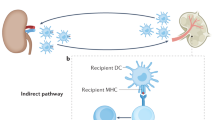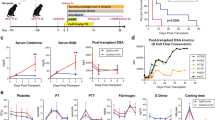Abstract
Accumulating evidence suggests that innate immunity interacts with the adaptive immune system to identify potentially harmful antigens and eliminate them from the host. A central facet of innate immunity is complement, which for some time has been recognized as a contributor to inflammation in transplant rejection but without detailed analysis of its role in what is principally a T cell–mediated process. Moreover, epithelial and vascular tissues at local sites of inflammation secrete complement components; however, the role of such local synthesis remains unclear. Here we show that the absence of locally synthesized complement component C3 is capable of modulating the rejection of renal allografts in vivo and regulating T-cell responses in vivo and in vitro. The results indicate that improved success in kidney transplantation could come from therapeutic manipulation of innate immunity in concert with T cell–directed immunosuppression.
This is a preview of subscription content, access via your institution
Access options
Subscribe to this journal
Receive 12 print issues and online access
$209.00 per year
only $17.42 per issue
Buy this article
- Purchase on Springer Link
- Instant access to full article PDF
Prices may be subject to local taxes which are calculated during checkout






Similar content being viewed by others
References
Kinoshita, T. Biology of complement: The overture. Immunol. Today 12, 291–295 (1991).
Passwell, J., Schreiner, G.F., Nonaka, M., Beuscher, H.U. & Colten, H.R. Local extrahepatic expression of complement genes C3, factor B, C2, and C4 is increased in murine lupus nephritis. J. Clin. Invest. 82, 1676–1684 (1988).
Andrews, P.A. et al. Expression and tissue localization of donor-specific complement C3 synthesized in human renal allografts. Eur. J. Immunol. 25, 1087–1093 (1995).
Brooimans, R.A. et al. Interleukin 2 mediates stimulation of complement C3 biosynthesis in human proximal tubular epithelial cells. J. Clin. Invest. 88, 379–384 (1991).
Andrews, P.A., Pani, A., Zhou, W. & Sacks, S.H. Local transcription of complement C3 in human allograft rejection. Evidence for a pathogenic role and correlation to histology and outcome. Transplantation 58, 637–640 (1994).
Tang, S., Zhou, W., Sheerin, S., Vaughan, R.W. & Sacks, S.H. Contribution of renal secreted complement C3 to the circulating pool in humans. J. Immunol. 162, 4336–4341 (1999).
Pratt, J.R., Abe, K., Miyazaki, M., Zhou, W. & Sacks, S.H. In situ localization of C3 synthesis in experimental acute renal allograft rejection. Am. J. Pathol. 157, 825–831 (2000).
Passwell, J.H., Schreiner, G.F., Wetsel, R.A. & Colten, H.R. Complement gene expression in hepatic and extrahepatic tissues of NZB and NZB×W (F1) mouse strains. Immunology 71, 290–294 (1990).
Hagerty, D.T. & Allen, P.M. Processing and presentation of self and foreign antigens by the renal proximal tubule. J. Immunol. 148, 2324–2330 (1992).
Kelley, V.R. & Singer, G.G. The antigen presentation function of renal tubular epithelial cells. Exp. Nephrol. 1, 102–111 (1993).
Banu, N. & Meyers, C.M. IFN-γ and LPS differentially modulate class II MHC and B7-1 expression on murine renal tubular epithelial cells. Kidney Int. 55, 2250–2263 (1999).
Takei, Y., Sims, T.N., Urmson, J. & Halloran, P.F. Central role for interferon-γ receptor in the regulation of renal MHC expression. J. Am. Soc. Nephrol. 11, 250–261 (2000).
Meri, S. & Jarva, H. Complement regulation. Vox Sang. 74 (Suppl. 2), 291–302 (1998).
Kozono, Y. et al. Cross-linking CD21/CD35 or CD19 increases both B7-1 and B7-2 expression on murine splenic B cells. J. Immunol. 160, 1565–1572 (1998).
Janeway, C.A. Approaching the asymptote? Evolution and revolution in immunology. Cold. Spring Harb. Symp. Quant. Biol. 54 (Pt. 1), 1–13 (1989).
Matzinger, P. An innate sense of danger. Sem. Immunol. 10, 399–415 (1998).
Arvieux, J., Yssel, H. & Colomb, M.G. Antigen-bound C3b and C4b enhance antigen-presenting cell function in activation of human T-cell clones. Immunol. 65, 229–235 (1988).
Jacquier-Sarlin, M.R., Gabert, F.M., Villiers, M.B. & Colomb, M.G. Modulation of antigen processing and presentation by covalently linked complement C3b fragment. Immunol. 84, 164–170 (1995).
Prechl, J. & Erdei, A. Immunomodulatory functions of murine CR1/2. Immunopharmacology 49, 117–124 (2000).
Dempsey, P.W., Allison, M.E., Akkaraju, S., Goodnow, C.C. & Fearon, D.T. C3d of complement as a molecular adjuvant: Bridging innate and acquired immunity. Science 271, 348–350 (1996).
Mongini, P.K., Vilensky, M.A., Highet, P.F. & Inman, J.K. The affinity threshold for human B cell activation via the antigen receptor complex is reduced upon co-ligation of the antigen receptor with CD21 (CR2). J. Immunol. 159, 3782–3791 (1997).
Tosello, A.C., Mary, F., Amiot, M., Bernard, A. & Mary, D. Activation of T cells via CD55: Recruitment of early components of the CD3-TCR pathway is required for IL-2 secretion. J. Inflam. 48, 13–27 (1998).
Cheng, P.C., Dykstra, M.L., Mitchell, R.N. & Pierce, S.K. A role for lipid rafts in B cell antigen receptor signaling and antigen targeting. J. Exp. Med. 190, 1549–1560 (1999).
Biancone, L. et al. Alternative pathway activation of complement by cultured human proximal tubular epithelial cells. Kidney Int. 45, 451–460 (1994).
Zhou, W., Farrar, C.A. et al. Predominant role for C5b-9 in renal ischemia/reperfusion injury. J. Clin. Invest. 105, 1363–1371 (2000).
Morgan, B.P. & Gasque, P. Extrahepatic complement biosynthesis: Where, when and why? Clin. Exp. Immunol. 107, 1–7 (1997).
Abe, K. et al. Expression of decay accelerating factor mRNA and complement C3 mRNA in human diseased kidney. Kidney Int. 54, 120–130 (1998).
Breitner, S., Storkel, S., Reichel, W. & Loos, M. Complement components C1q, C1r/C1s, and C1INH in rheumatoid arthritis. Correlation of In situ hybridization and northern blot results with function and protein concentration in synovium and primary cell cultures. Arthritis Rheum. 38, 492–498 (1995).
Gasgue, P., Fontaine, M. & Morgan, B.P. Complement expression in human brain. Biosynthesis of terminal pathway components and regulators in human glial cells and cell lines. J. Immunol. 154, 4726–4733 (1995).
Kalina, S.L. & Mottram, P.L. A microsurgical technique for renal transplantation in mice. Aust. N. Z. J. Surg. 63, 213–216 (1993).
Pratt, J.R., Hibbs, M.J., Laver, A.J., Smith, R.A. & Sacks, S.H. Effects of complement inhibition with soluble complement receptor-1 on vascular injury and inflammation during renal allograft rejection in the rat. Am. J. Pathol. 149, 2055–2066 (1996).
Tang, S., Sheerin, N.S., Zhou, W., Brown, Z. & Sacks, S.H. Apical proteins stimulate complement synthesis by cultured human proximal tubular epithelial cells. J. Am. Soc. Nephrol. 10, 69–76 (1999).
Sheerin, N.S., Springall, T., Abe, K. & Sacks, S.H. Protection and injury: The differing roles of complement in the development of glomerular injury. Eur. J. Immunol. 31, 1255–1260.
Sasaki, O. et al. Intraglomerular C3 synthesis in rats with passive Heymann nephritis. Am. J. Pathol. 151, 1249–1256 (1997).
Author information
Authors and Affiliations
Corresponding author
Ethics declarations
Competing interests
The authors declare no competing financial interests.
Rights and permissions
About this article
Cite this article
Pratt, J., Basheer, S. & Sacks, S. Local synthesis of complement component C3 regulates acute renal transplant rejection. Nat Med 8, 582–587 (2002). https://doi.org/10.1038/nm0602-582
Received:
Accepted:
Issue Date:
DOI: https://doi.org/10.1038/nm0602-582
This article is cited by
-
Adipose tissue-derived human mesenchymal stromal cells can better suppress complement lysis, engraft and inhibit acute graft-versus-host disease in mice
Stem Cell Research & Therapy (2023)
-
Complosome — the intracellular complement system
Nature Reviews Nephrology (2023)
-
The role of complement in kidney disease
Nature Reviews Nephrology (2023)
-
Endothelial-derived complement factor D contributes to endothelial dysfunction in malignant nephrosclerosis via local complement activation
Hypertension Research (2023)
-
Fucose as a new therapeutic target in renal transplantation
Pediatric Nephrology (2021)



